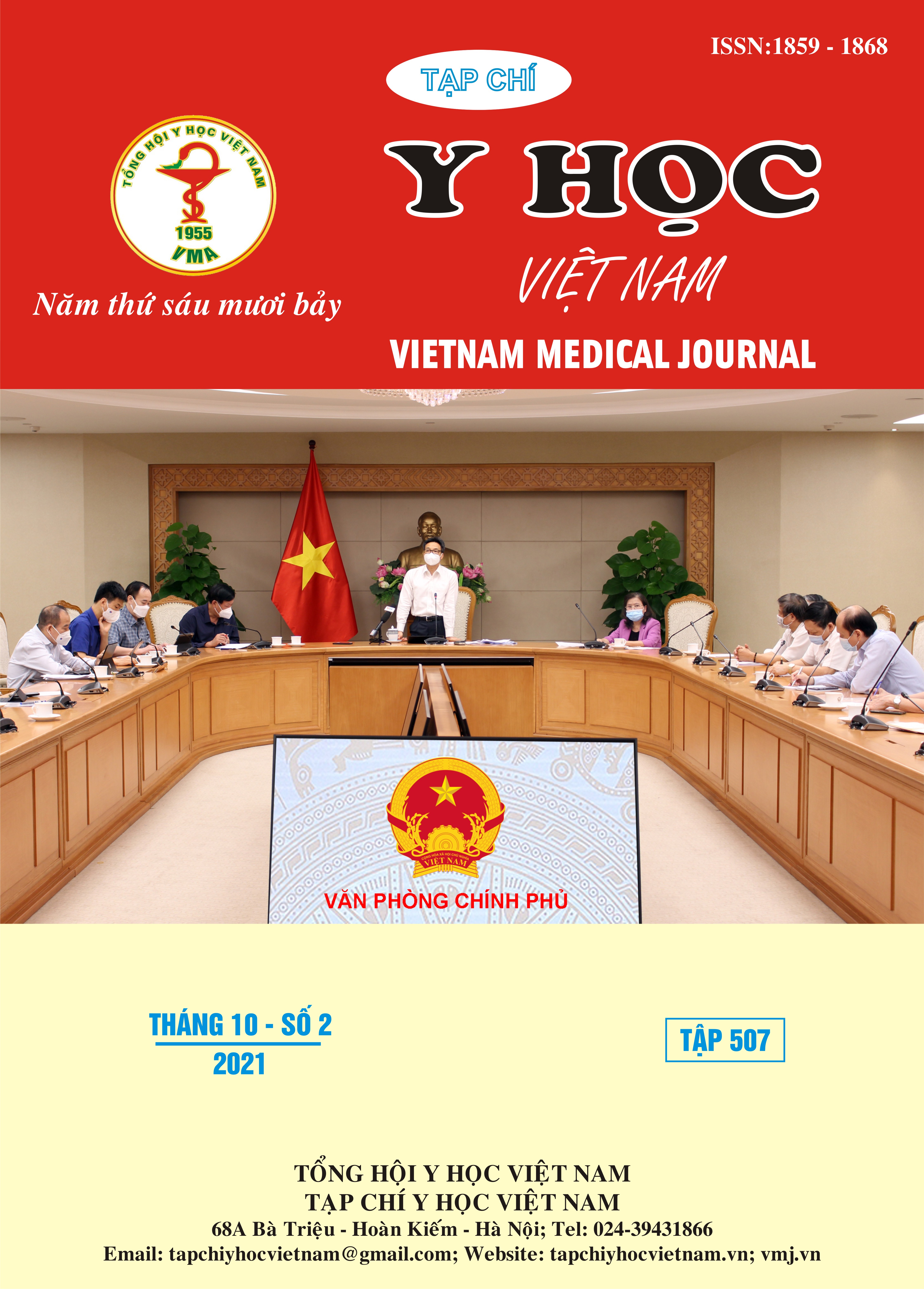THE RESULTS OF 3D-CRT vs VMAT IN CONCURRENT CHEMORADIOTHERAPY FOR ESOPHAGEAL CANCER
Main Article Content
Abstract
Objective: Describe some clinical and paraclinical characteristics and evaluate the results of radiaotherapy by 3D-CRT and VMAT techniques in patients with concurrent chemoradiotherapy with esophageal cancer at K hospital. Subjects ad methods: A retrospective and prospective descriptive study on 60 patients undergoing concurrent chemoradiotherapy for esophageal cancer with 3D-CRT and VMAT techniques at K hospital from May 2018 to May 2021. Results: Mean age 54.4 ± 7.0 (43-69). The male/female ratio is 59/1. Swallowing rate 91.7%. There are 46 (76.7%) patients at T3 stage, 14 (23.3%) patients at T4 stage. The histopathology of the patients was squamous cell carcinoma (100%). Parameters of dose coverage to PTV (planning target volume) of VMAT radiotherapy compared with 3D-CRT: V95: 98.4% - 94.35%, V110: 0.15%-5,35%. Dmax at marrow and skin VMAT is lower than 3D-CRT. The dose in the lungs (V5,V20) and at the heart (V40) of VMAT was lower than that of 3D-CRT. The overall response rate after chemotherapy and radiotherapy was 48.3%, the partial response rate was 41.7%, the disease rate remained unchanged at 10%. Hematologic toxicity was leukopenia (6%), thrombocytopenia (1.7%). Radiation-induced dermatitis (58.4%), radiation-induced esophagitis (18.3%), radiation-induced pneumonia toxicity (3.3%), no cardiovascular toxicity was noted. Conclusion: Radiation therapy for esophageal cancer by VMAT and 3D-CRT techniques gives good and safe results, the VMAT technique shows better radiation dose concentration and less toxicity than 3D-CRT technique.
Article Details
Keywords
Esophagus Cancer, concurrent chemoradiotherapy, 3D-CRT technique, VMAT technique
References
2. Nguyễn Chấn Hùng, Nguyễn Bá Đức (2003). Kết quả bước đầu nghiên cứu dịch tễ học mô tả một số bệnh ung thư tại 6 vùng địa lý Việt Nam giai đoạn 2001-2003. Tạp Chí Học TPHCM. 13(5):23–64.
3. HànThị Thanh Bình (2004). Nhận xét đặc điểm lâm sàng, mô bệnh học và kết quả điều trị ung thư biểu mô thực quản tại bệnh viện K giai đoạn 1998 - 2004.Luận văn Bác sỹ nội trú, Đại học Y Hà Nội
4. Carcinoma of the Esophagus. Accessed September 21, 2020. https://www. cambridge.org/ core/books/carcinoma-of-the esophagus/841ACDC360FA07FD66C139B2C18E734A
5. J S, Jjb van L, Mccm H, et al. Neoadjuvant chemoradiotherapy plus surgery versus surgery alone for oesophageal or junctional cancer (CROSS): long-term results of a randomised controlled trial. The Lancet. Oncology. doi:10.1016/S1470-2045(15)00040-6
6. Stahl M, Stuschke M, Lehmann N, et al. Chemoradiation withandwithoutsurgery in patientswithlocallyadvancedsquamouscellcarcinoma of the esophagus. J Clin Oncol Off J Am Soc Clin Oncol. 2005;23(10):2310-2317. doi:10.1200/ JCO.2005.00.034
7. Nguyễn Đức Lợi (2015). Đánh giá hiệu quả phác đồ hóa xạ đồng thời và một số yếu tố tiên lượng ung thư biểu mô thực quản giai đoạn III - IV tại bệnh viện K. Luận án tiến sỹ y học, Đại học Y Hà Nội.
8. Tepper J, Krasna MJ, Niedzwiecki D, etal. Phase III Trial of Trimodality Therapy With Cisplatin, Fluorouracil, Radiotherapy, and Surgery Compared With Surgery Alone for Esophageal Cancer: CALGB 9781. J Clin Oncol Off J Am Soc Clin Oncol. 2008;26(7):1086-1092. doi:10.1200/ JCO.2007.12.9593
9. De Vita F, Di Martino N, Orditura M, etal. Preoperative Chemoradiotherapy for Squamous Cell Carcinoma and Adenocarcinoma of the Esophagus: A Phase II Study. Chest. 2002; 122(4):1302-1308. doi:10.1378/ chest.122.4.1302


